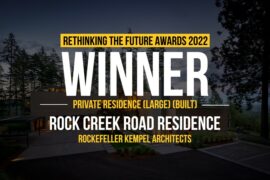Project Statement: The project, named ‘from Gold to Pearl’ proposes a framework of eco-friendly industry catalyzing river revitalization for river waterfront landscape design and takes advantage of various ecological problems, such as an excess of sediments and heavy mental and degradation of riparian habitats that stem from Gold Rush, as opportunities for Sacramento River revitalization. This project seeks to make full use of the unattractive vacant areas along Sacramento River in order to achieve riparian habitat recovery, storm water management, waterfront activity space recreation and pearl industry development. It can also rebuild a unique identity for Sacramento River as ‘Pearl River’ with ecological sustainable development in the new era instead of the controversial ‘Gold River’.
Designer: Yu PU & Lan LUO
Location: Sacramento, California, USA
Status: Concept

Project Narrative: River as the bearer of the history and civilization of the region, has witnessed the city’s wax and wane. It could be defined by historical events or special function in every era. Its identity would be rebuilt in a new era.
Such is the case of Sacramento River whose definition changed from Fertile River for Indians to Golden River in Gold Rush, implying big change of Sacramento. The heyday that California accounts for 45% of global gold production has ended; nonetheless, ecological problems still remain, such as sediment, heavy mental excess and aquatic species reduction. For the reason of its unsustainability and prodigious ecological rava-ges, gold mining industry is on the wane nowadays, which threatens the identity of ‘Golden River’ after Gold Rush.

The Symptom
- Sediment
Surface mining strips away the overburden and exposes underlying coal seams, resulting in significant increased sediments in river and greatly influencing the development of river so far. Chronic sedimentation can gradually alter the composition of aquatic species, especially mussels through habitat degradation. - Heavy mental
In the past 150 years, heavy mental pollution, especially mercury created by mining and processing activities in California has a profound impact on the environment of Sacramento River. Heavy metals concentrations in previous years have been toxic to fish in the downstream from Redding. Mercury is currently considered as the most serious water-quality problem in Sacramento River, especially in some tributaries and downstream locations, including the San Francisco Bay. - Habitat Degradation
The riparian areas along the Sacramento once totaled more than 500,000 acres. However, today only around 10,000 acres remains. Wildlife, vegetation and wetland system along the Sacramento has been hurt severely by the pollution caused by mine tailings, acid mine drainage andurban runoff. After more than 150 years from ‘Gold Rush’, the aquatic species have declined sharply, accounting for only 35% of the past. - Flooding & Shortage
Levee system along Sacramento River has impeded the interaction between residents and river seriously and imposed severe damage to original riverbank, resulting in soil erosion and excess sediment to river during flooding. The groundwater of Central Valley has been depleted by approximately 1.85 km3 per year on average since 1960, and has been depleted about twice this rate during the current drought. - Lack of Waterfront Space
Recreational facilities are fairly spread across the cities which Sacramento River flows through, but are limited along the river. Almost 20% of present parks along the river are vacant and unattractive to residents due to poor maintenance. - Loss of Identity
Over 80% of people believe that river is defined by historical event or its special function, while only 25% of them agree that “Golden River” is the proper identity for now.

Planning Strategies
America as the world’s largest pearl market is facing a severe situation that only 15.7% of freshwater pearls are domestic products. Sacramento River is suitable in cultivating freshwater pearls due to rich nutrition. Thus, it is feasible to develop the pearl industry to supply the pearl market. Furthermore, mussels as filter feeders play a significant role in accumulating heavy mental and clarifying water, and are widely used as bio-indicators to monitor the health of aquatic environments.
High breeding density of traditional cultivation can easily cause the problem of water pollution. Thus, we need to create a new Mussel Cultivation Floating Bed to meet the needs of rational density, mobility, changeability, shade and root-filter for best pearl cultivation. In order to take advantage of the existing site conditions and problems as opportunities for Sacramento River revitalization, the plan ‘from Gold to Pearl’ including three planning strategies is proposed as below:

- Sedimentation / Phytoremediation
Forming natural shoals through intercepting silt in water would reduce sediments in river and recreate habitat for wildlife; phytoremediation can reduce heavy mental in both water and soil. - Pearl Industry / Bioamplification
Not only could eco-friendly pearl industry bring economic benefits to this region, but also decrease the amount of heavy metals, especially Hg through bioampification of mussels. - Storm water Management / Waterfront Restoration
Replenishing aquifers through storm water management and rainwater retention would alleviate shortages; enforcing riverbank and welcoming flood would recover wetland and create mutualistic waterfront activity spaces.

The Design
The design seeks to offer a template for “from Gold to Pearl” and set up a framework of eco-friendly industry catalyzing river revitalization based on the three strategies.
The site covering 300000 square meters is contiguous with the big community of West Sac and the tourist attraction in Old Sac, which is facing an excess of sediments and heavy mental from Sacramento River and American River, and is unattractive for residents due to poor maintenance. The operations require a series of proposed changes and a long-term evolution after the analysis on the dynamic water table, vegetation resources and traffic of the site. The design consists of three functional layers, including riparian habitat recovery, storm water management and pearl industry.
- Riparian Habitat Recovery
Water from Sacramento River would be treated through an integrated system with deceleration, sedimentation, aeration, bio-amplification and root-zone filtration, and would be finally utilized for pearl cultivation. The Shoals formed through baffle interception would become habitats of wildlife after phytoremediation. Moreover, the superfluous silt would be treated through Silt Dehydration Floating Beds, which offer a platform for scientists to operate Hg related researches. Real time monitoring of water quality, soil, fish and vegetation updated on the internet would ensure the safety of aquatic production. In addition, such visible ecological rehabilitation system provides a center for environmental education in the region. - Storm Water Management
This layer seeks to alleviate the intensity of flood events and water shortages through storm water management and rainwater retention. On the one hand, flood is no more prevented from tall levees. Instead, it is invited to the site through pushing original levee back and reshaping topography to fertilize riverbank and improve the recovery of wetland ecosystem. On the other hand, runoffs from urban side would be selected and filtered through regraded segments to replenish groundwater and satisfy public water demands. Multilevel riverside road and pedestrian overpass could conform to fluctuant water and inspire the interaction between people and river even during flooding. - Pearl Industry
Pear industry consists of three parts, including cultivation, process and sale. After treatment, river water and urban runoffs would unceasingly drain into culture area for cultivation use and deeper heavy mental purification, and finally run into Sacramento River. Pear factory and shops contribute to the process of mussel and pearl and local sales of pear jewelry. Floating market as the destination of water tourism will definitely attract more visitors to experience the novel sales approaches, such as Pearl Mussel Adoption, and meanwhile bring more economic profits and employment opportunities.

From Gold to Pearl
As a generative waterfront landscape, this site creates a triangular connection between the big community of West Sac and the tourist attraction of Old Sac, and gradually develops into a center of freshwater pearl trades and municipal public activities for residents and visitors. In addition, it serves as a wildlife shelter, offering an opportunity for people to learn the nature and culture of Sacramento River.
“From Gold to Pearl” proposes the framework of eco-friendly industry catalyzing river revitalization for the design of river waterfront landscape. The widespread usage of the proposed plan along Sacramento River would improve water quality, recover wetland ecosystem, store floodwater and achieve economic growth. It can also rebuild the identity for Sacramento River as “Pearl River” with ecological sustainable development in new age instead of the controversial “Gold River”.

Pu YU and Lan LUO
Pu YU received her Master of Landscape Architecture in China and has participated diverse landscape design projects in Turenscape. With her enthusiasm of exploring multi-scale design, she is now majoring in Urban Design in the Graduate School of Design of Harvard University. It operated as a main idea throughout her projects, finding conflicts and opportunities through interdisciplinary thought and the creative design strategy.
Lan LUO is a Ph.D student, majoring in Landscape Architecture, from Department of Architecture of the University of Hong Kong. Her research interest is exploring the relationship between built environments and human health. Lan always believe landscape design should be based on evidence, experiment and research as well as should promote human well-being.





